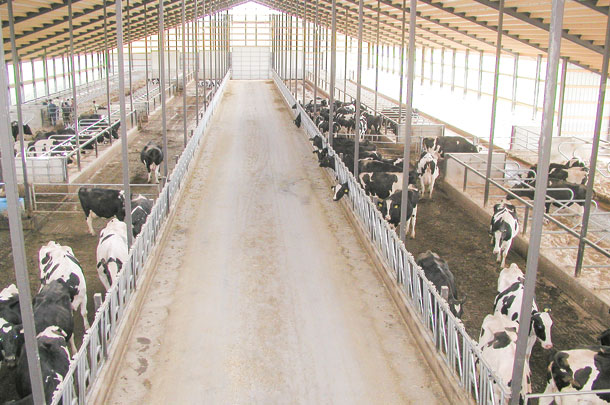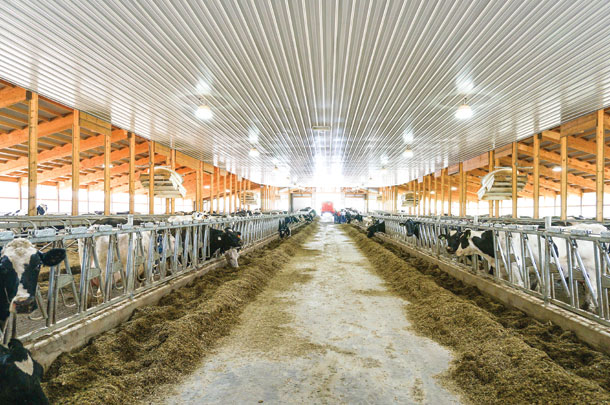Currently, ventilation and cooling are hot topics in dairying.
While everyone agrees that we need to improve ventilation to provide cows fresh air, especially in the winter, and they need fast-moving air for cooling in the summer, deciding on the best system for a particular dairy is neither simple nor clear-cut.
Freestall barns use either natural or mechanical ventilation. Naturally ventilated barns have open sidewalls and steeper roof pitches to promote air movement toward an open ridge through thermal buoyancy or the “chimney effect” during the winter.
This drives the humid, contaminated air from the barn and facilitates the in-flow of fresh air. High, open-curtain sidewalls let in wind during the summer, but on still days air movement needs some assistance.
The term “natural ventilation” can be confusing because many of these barns also have fans mounted above the feedline and stalls for use in the summer to provide this fast-moving air. However, these fans mostly recirculate indoor air as opposed to providing fresh air from outside to ventilate the barn.
 Mechanical ventilation provides more control over ventilation and allows buildings to be closer together, or house more cows per square foot of available space. Typically, they are set up as tunnel barns, where air is drawn along the length of the barn, or cross-ventilated barns, where air is drawn across the barn, perpendicular to the pen alleys.
Mechanical ventilation provides more control over ventilation and allows buildings to be closer together, or house more cows per square foot of available space. Typically, they are set up as tunnel barns, where air is drawn along the length of the barn, or cross-ventilated barns, where air is drawn across the barn, perpendicular to the pen alleys.
Fan efficiency allows us to create wide-body, cross-ventilated barns with eight to 16 rows of stalls, rather than four or six rows. However, these barns have higher operational costs through the year. In addition, the very large fans used to move as much air as possible in the summer present a challenge in the winter.
Typically, only 5 to 10 percent of the system is operating during the winter to avoid fast-moving cold air on the cows, often leading to improper fresh air distribution.
It can be difficult for a producer to determine the best ventilation system for their specific needs. Producers should keep in mind the characteristics of their property and desired level of control over ventilation when making a decision.
 Naturally ventilated barns require an area with no obstruction to the natural wind path and should be oriented to take advantage of prevailing wind direction in the area, which is usually east-to-west in North America.
Naturally ventilated barns require an area with no obstruction to the natural wind path and should be oriented to take advantage of prevailing wind direction in the area, which is usually east-to-west in North America.
The barns will have high side walls and roof pitches of typically 4-in-12, creating ridges around 30 feet high. However, depending on the dairy’s size, natural ventilation may utilize a larger square footage of land than tunnel or cross.
When deciding between natural and mechanical ventilation, space and wind availability will likely drive the decision as opposed to cost.
One of the biggest challenges in new barn design is finding an agreement between ideal ventilation and financial viability. For example, in an H-configuration for naturally-ventilated barns, ideally one would avoid wind shadows by placing enough distance between the barns.
However, each extra foot between the barns adds concrete costs, distance the cows and workers have to traverse and takes away square footage from your site. Practically, barns are usually spaced 100 feet apart, which likely does not optimize access to wind through the sidewalls.
Mechanical ventilation allows the producer to decide on the barn location and orientation, but that freedom is offset with fan and electricity costs. The design of the barn and the desire to bring air movement closer to the cow leads to designs with lower roof pitches – typically 0.5-in-12 for wide-body, cross-vent barns and 2-in-12 for tunnel barns.
These choices often take away the option to naturally ventilate the barn as well as mechanically ventilate it, requiring a generator capable of running at least enough of the fans to provide adequate ventilation in case of a power outage. However, the biggest issue with mechanical ventilation is that current dairy barn designs accommodate large machinery; creating large, unobstructed alleyways that air loves to flow through.
Air is lazy; it always takes the path of least resistance. Stalls, waterers, walls and countless other obstructions prevent air from reaching the cow. Farmers find themselves installing baffles or pusher fans in an attempt to move air back into the stalls – adding cost to the design.
To ensure sufficient air speed at the cow, system designers have increased air speeds over the years from 2.5 mph to around 6 mph or more, assuming air will not be distributed evenly, to ensure reasonable air flow where the cows live.
Natural ventilation remains a good option if the correct land area and wind conditions are present. If not, mechanical systems can deliver excellent air flow for summer ventilation with the use of low roof pitches and carefully located baffles and pusher fans.
Winter ventilation remains a challenge with these systems and in the future, a hybrid design capable of natural ventilation in the winter and mechanical ventilation in the summer may be the optimal design. We are starting to see some hybrid barns in the industry and it will be interesting to see how they perform. PD
PHOTO 1: Cross-ventilated barns have higher operational costs, but the design gives the producer more freedom in barn location and orientation.
PHOTO 2: Naturally ventilated barns have open sidewalls and steeper roof pitches to promote air movement toward an open ridge through thermal buoyancy or the “chimney effect” during the winter.
PHOTO 3: Tunnel ventilation is another form of mechanical ventilation that uses fans to move air through the barn. Photos courtesy of Dairyland Initiative.

-
Mario Mondaca
- Research Associate
- Dairyland Initiative School of Veterinary Medicine
- Email TMario Mondaca






